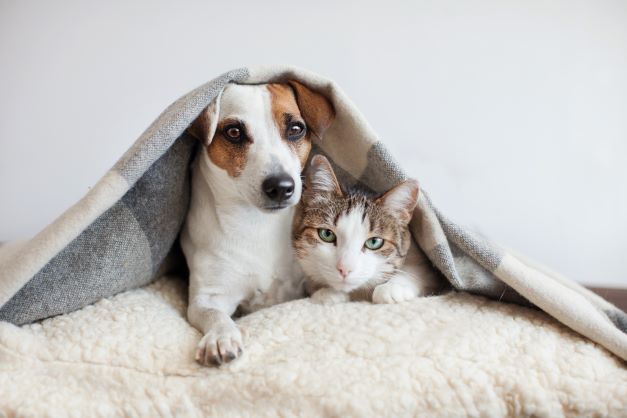Tails
Making pet parenting easy

10 Tips for Preparing Your Pets for Winter Weather
This entry was posted on 2022-05-05.
The leaves are falling and people are pulling out their long sleeves and cozy blankets. As you prepare your home for the cooler weather, make sure you spend some time thinking about how your fur kid will be affected by the changing temperatures. Although they are generally better equipped to deal with the cold than humans, it is up to us to be sure that they are safe from the many hazards that come with colder weather.
Here are our top 10 tips for preparing your pet for winter weather:
1. Visit Your Vet
If your fur kid has chronic health issues, like diabetes, heart disease or arthritis, it can be even harder for them to self-regulate their temperature or move about. It is not a bad idea to take them for a check-up to their vet before the cold weather hits.
If they have not been diagnosed with arthritis or other joint issues but are showing signs such as limping, stiffness, reluctance to climb or jump, repeated licking over a joint, or changes in behaviour or personality, particularly during cold weather, it's best to consult with your veterinarian.
2. Bring Your Fur Kid Inside
With the exception of cold-weather breeds like the husky, most dogs do not like the cold. If you think it is cold outside, it’s too cold for your pup to be outside. They will also be better off inside, especially ones with health conditions like those discussed above.
If you’re not home when your fur kid is outside, provide a warm shelter, such as a kennel designed for the cold. These shelters should be dry and kept a few inches off the floor, and have a covered doorway. A piece of fabric can keep out the moisture while holding some of your fur kids' heat inside. The home should be just big enough that your pup or feline friend can move easily, but just small enough to retain body heat.
3. Take Shorter Walks with Your Pup
During winter time there are added dangers to hiking – your pup. Debris can stick to their feet during walks or while playing outside. Fur kids are likely to lick their paws to clean them, but be especially careful about excessive licking that could cause infections. The best tactic is to always clean and dry those sensitive paws when they come back into the home. It can also be helpful to keep the hair appropriately trimmed on the paws. Dog boots are great for keeping your pup's paws insulated while protecting from the elements and rough terrain. Snout and Paw Butter is a great way to help protect their nose and feet from the cold or from drying out.
4. Bundle them up
Having a coat (fur) does not mean your pup is okay without additional protection from the cold. Small, short-haired, and short-legged breeds may need a jacket or sweater to help ward off the winter chill. Young, old, and sick pets should also wear an extra layer as they may not be able to regulate their body temperature effectively. Make sure to choose something that fits well and does not restrict movement. Also consider a snood to protect his ears on especially cold days.
5. Make Sure Your Fur Kid is chipped
When your fur kid gets out in the rain or stormy weather they can quickly become disoriented and lost. Protect them with a microchip and up-to-date name tags. Remember to keep the data associated with the chip up to date.
6. Be Mindful of Seasonal Dangers Around the House
Winter dangers are not all outdoors. Keep winter-related supplies and accessories out of their reach.
7. Keep Giving Flea Meds
Flea meds are expensive, and it’s tempting to discontinue them during the cold winter months when fleas lie dormant. But that can leave your precious one vulnerable to fleas and the parasites they carry when the weather warms back up again. Plus, if you don’t restart meds soon enough, you could quickly find your house overrun with fleas and have to bomb. It’s easier and safer, all around, to keep treating your pets for fleas through the winter, so they remain protected.
8. Brush Out Fluffy Coats of Fur
If your fur kid has a full coat, be sure to brush it out regularly. Matted fur does not provide the same insulation as a clean coat. In addition to keeping things clean, unbrushed hair might trap moisture, leading to discomfort and irritation. There are a variety of brushes tailored to your fur kids needs.
9. Add an Extra Blanket
Make sure the sleeping area is away from drafty windows or doors and off the floor (but not too high or difficult to access). Try moving your fur kids bed to a sunny area of the house or add a few extra blankets.
10. Add More Calories to the Diet and Offer Extra Water
In addition to keeping your fur kid hydrated, consider providing extra treats.This is a good idea for several reasons during the holidays, but it can also provide a few extra calories that are important to helping your furry friends stay warm after playing hard in the cold.
It is very important that they stay well-hydrated if they are going to be able to regulate their body temperature.


